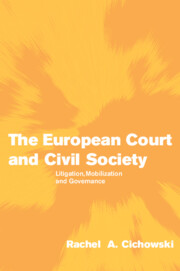Book contents
- Frontmatter
- Contents
- List of figures
- List of tables
- Acknowledgments
- 1 Introduction: institutions, organizations and actors
- 2 Overview of institutionalization in the European Union
- Part I Institutionalization through litigation
- 3 The European Court of Justice and the expansion of gender equality rights
- 4 Environmental protection, non-compliance and judicial politics
- Part II Institutionalization through mobilization
- References
- Index
4 - Environmental protection, non-compliance and judicial politics
Published online by Cambridge University Press: 22 September 2009
- Frontmatter
- Contents
- List of figures
- List of tables
- Acknowledgments
- 1 Introduction: institutions, organizations and actors
- 2 Overview of institutionalization in the European Union
- Part I Institutionalization through litigation
- 3 The European Court of Justice and the expansion of gender equality rights
- 4 Environmental protection, non-compliance and judicial politics
- Part II Institutionalization through mobilization
- References
- Index
Summary
The origins of European Union (EU) environmental protection are not traceable to the Treaty of Rome. The original three treaties lacked any mention of the “environment,” an unsurprising fact as ecological sensibilities were not commonplace in 1957. Today, environmental protection possesses a formal constitutional basis under EU law. Beyond technical measures to ensure proper waste disposal systems, the Treaty calls for integrating environmental protection and sustainable development into all EU policies. Further, EU environmental measures were developed by national governments as a result of their concern over unfair competition created by varying national environmental regulations. Yet today environmental activists are able to use these same EU laws against the very governments who created them in order to pressure for higher environmental standards.
This institutional evolution is the focus of this chapter. In particular, similar to Chapter 3, I explore the European Court of Justice's (ECJ) environmental case law pursuant to Article 234 to examine how processes of institutionalization through litigation influenced this policy development. Through similar analyses as Chapter 3, I examine institutionalization through litigation as a set of interrelated processes and examine how national level activists, EU organizations and national governments play a part in this evolution. The analyses in this chapter serve to test our expectation of these processes in the area of environmental protection and in doing so, enable us to understand the considerable cross-sector variation that exists in litigation.
- Type
- Chapter
- Information
- The European Court and Civil SocietyLitigation, Mobilization and Governance, pp. 119 - 168Publisher: Cambridge University PressPrint publication year: 2007



